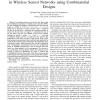Free Online Productivity Tools
i2Speak
i2Symbol
i2OCR
iTex2Img
iWeb2Print
iWeb2Shot
i2Type
iPdf2Split
iPdf2Merge
i2Bopomofo
i2Arabic
i2Style
i2Image
i2PDF
iLatex2Rtf
Sci2ools
146
click to vote
INFOCOM
2011
IEEE
2011
IEEE
Fully secure pairwise and triple key distribution in wireless sensor networks using combinatorial designs
—We address pairwise and (for the first time) triple key establishment problems in wireless sensor networks (WSN). We use combinatorial designs to establish pairwise keys between nodes in a WSN. A BIBD(v, b, r, k, λ) (or t − (v, b, r, k, λ)) design can be mapped to a sensor network, where v represents the size of the key pool, b represents the maximum number of nodes that the network can support, k represents the size of the key chain. Any pair (or t-subset) of keys occurs together uniquely in exactly λ nodes. λ = 2 and λ = 3 are used to establish unique pairwise or triple keys. Our pairwise key distribution is the first one that is fully secure (none of the links among uncompromised nodes is affected) and applicable for mobile sensor networks (as key distribution is independent on the connectivity graph), while preserving low storage, computation and communication requirements. We also use combinatorial trades to establish pairwise keys. This is the first time that trades ...
Combinatorial Approach | Combinatorial Designs | Communications | INFOCOM 2011 | Wireless Sensor Networks |
Related Content
| Added | 30 Aug 2011 |
| Updated | 30 Aug 2011 |
| Type | Journal |
| Year | 2011 |
| Where | INFOCOM |
| Authors | Sushmita Ruj, Amiya Nayak, Ivan Stojmenovic |
Comments (0)

